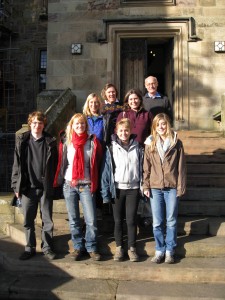
November 2, 2012, by Matt
A Day in the Life of a Geographer … Suzanne McGowan (and friends)
Nottingham geographers at the British Diatom Meeting 2012 in Northumberland
The British Diatom meeting has become something of a tradition among those who work on diatoms (microscopic siliceous algae). The meeting annually brings together academics, practitioners and amateur enthusiasts to discuss all aspects of diatom research ranging from ecology to evolution and taxonomy to palaeo-science. Last weekend, five geographers from Nottingham braved the blizzards up the A1 to attend the meeting meeting at Ford Castle, organised by Steve Juggins and Emma Pearson from Newcastle University.
The venue was a 14th century castle, now renovated and run as an educational centre. It was the perfect place to spend a pre-Hallowe’en weekend with secret tunnels, a dungeon and a playground with a ball pool in the basement (a favourite with a particular eminent UCL diatomist). But of course we were there to talk about, collect and look at diatoms. The talks at the meeting covered a range of topics such as the effects of flood pulses on river diatoms, biodiversity in the Okavango Delta, carbon isotopes in organic inclusions within diatom silica, use of museum specimens to investigate changes in coastal diatoms and palaeolimnological reconstructions from lakes in Kenya, Mexico & Greenland. There were also lots of posters (including one presented by Nottingham PhD student Sarah Roberts on her Masters work looking at Holocene environmental change in northern Finnmark), 3D photo-visualisations of algae and a microscope to allow observation of newly collected material.
Saturday afternoon was spent taking a walk along the beach at Bamburgh Castle, in preparation for the evening’s entertainment: David Mann’s video presentation of diatom sex. The new research in this area has shown that some groups of diatoms send out a type of ‘fishing line’ to trap their partner cell before reproduction. A fascinating insight into the private life of diatoms, and one which encouraged several diatomists to later try to emulate this with the ‘fishing line dance’.
This year is the 100th birthday of John Lund CBE, DSc, FRS, FIBiol, FCIWEM, one of the founding fathers of algal ecology, and one of the earliest scientists to work at the Freshwater Biological Association in Windermere. To celebrate this, his PhD student Liz Haworth is piecing together his academic family tree to trace all those scientists who have been influenced by his work. We discovered a strong Nottingham link because four students attending the conference (Antonia Liversidge, Heather Moorhouse, Sarah Roberts, Mark Stevenson) were supervised by Suzanne McGowan who was supervised by Liz Haworth, leading back up to John Lund. This photo shows the diatomists present at the meeting who have been influenced by John Lund (also including David Mann who supervised Sarah Davies, also pictured, from the University of Aberystwyth). The full academic family tree will of course be much bigger. Happy 100th Birthday John Lund.


nice picture, Suzanne! I still remember your smile on my first field trip in the UK. It’s always nice to travel with you. Your friends are lucky:)